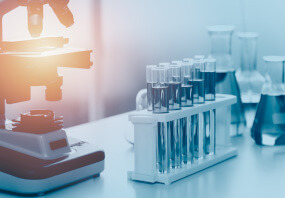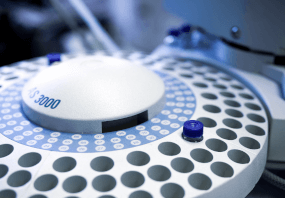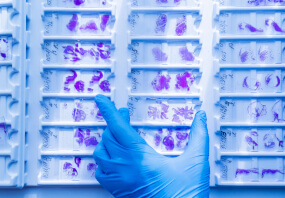General description
Fibroblast growth factor 9 (UniProt P31371; also known as FGF-9, GAF, Heparin-binding growth factor 9, Glia-activating factor, HBGF-9) is encoded by the FGF9 (also known as SYNS3) gene (Gene ID 2254) in human. Fibroblast growth factor 9 (FGF9) belongs to the FGF family of proteins that regulate a variety of cell functions, including proliferation, differentiation, survival, and motility, via FGF receptors (FGFRs). FGF-9 interacts with several FGFRs and binds preferentially to FGFR3. FGF-9 is highly expressed in cancer-associated fibroblasts (CAFs) in gastric cancer and may play a pivotal role in the interaction between cancer cells and their surrounding stromal cells. FGF-9 is shown to induce MMP-7 expression in AGS and MKN28 gastric cancer cells, promoting invasion and cellular anti-apoptotic activity through activation of the Erk and Akt signaling pathways. In human brain, FGF-9 is primarily expressed by neurons in the cortex, hippocampus, thalamus, cerebellum, and spinal cord, as well as by glia in the hindbrain and spinal cord. Upregulated FGF-9 expression is found in postmortem hippocampus tissues from major depressive disorder (MDD) patients, while FGF-2 is downregulated in the depressed brain. Likewise, chronic intracerebroventricular administration of FGF-9 increased both anxiety- and depression-like behaviors in rats, while FGF-9 knockdown in the dentate gyrus of the hippocampus ameliorated anxiety-like behavior. Human FGF-9 is produced with a propeptide (a.a. 1-3), which is cleaved off posttranslationally to yield the mature protein.
Specificity
Clone 3A10.1 targets an internal sequence conserved among bovine, human, mouse, and rat species.
Immunogen
KLH-conjugated linear peptide corresponding to a sequence within the C-terminal half of human FGF-9.
Application
Anti-FGF-9, clone 3A10.1 , Cat. No. MABN1623, is a highly specific mouse monoclonal antibody that targets FGF-9 and has been tested in Immunohistochemistry (Paraffin) and Western Blotting.
Immunohistochemistry Analysis: A 1:250 dilution from a representative lot detected FGF-9 in human cerebellum, cerebral cortex, and pancreas tissue sections.
Research Category
Neuroscience
Quality
Evaluated by Western Blotting of recombinant human FGF-9.
Western Blotting Analysis: 2 µg/mL of this antibody detected 50 ng of E. coli expressed full-length recombinant human FGF-9.
Target description
~23 kDa (non-glycosylated recombinant mature hFGF-9) observed. 23.14/23.44 kDa (human mature/pro-form), 23.08/23.38 kDa (bovine mature/pro-form), 23.11/23.41 kDa (mouse & rat mature/pro-form), 23.16/23.46 kDa (porcine mature/pro-form) calculated. Uncharacterized bands may be observed in some lysate(s).
Physical form
Format: Purified
Protein G purified.
Purified mouse IgG2a in buffer containing 0.1 M Tris-Glycine (pH 7.4), 150 mM NaCl with 0.05% sodium azide.
Storage and Stability
Stable for 1 year at 2-8°C from date of receipt.
Other Notes
Concentration: Please refer to lot specific datasheet.
Disclaimer
Unless otherwise stated in our catalog or other company documentation accompanying the product(s), our products are intended for research use only and are not to be used for any other purpose, which includes but is not limited to, unauthorized commercial uses, in vitro diagnostic uses, ex vivo or in vivo therapeutic uses or any type of consumption or application to humans or animals.
- UPC:
- 51172826
- Condition:
- New
- Availability:
- 3-5 Days
- Weight:
- 1.00 Ounces
- HazmatClass:
- No
- MPN:
- MABN1623












